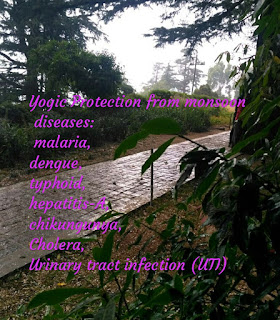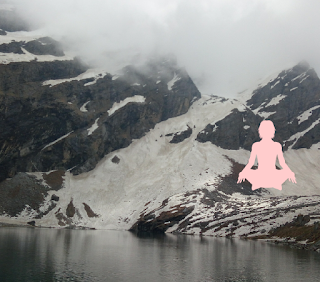How to Protect yourself from common monsoon diseases | yoga tips- asanas, mudra, shat karma and pranayamas
Monsoon brings relief from the scorching heat in June and the flora
sprout out quickly brings greenery everywhere, but monsoon is also an
impeccable environmental for the growth of various viruses and bacteria (the micro-organism to reproduce and
multiply in the hot and wet weather) giving rise to air-water borne
diseases such as malaria, dengue, typhoid, hepatitis-A, and chikungunya. All of
these diseases are known as monsoon diseases. These monsoon diseases come as
immunity is reduced during this time by fever taking hold of one’s body, which
is a common occurrence during monsoon. Cold and flu are the most common form of
viral infection.
Malaria is caused by the bite of female anopheles mosquito which
proliferates in stagnant water; an infective disease caused by sporozoan
parasites that are transmitted through the bite of an infected Anopheles
mosquito; marked by paroxysms of chills and fever. Symptoms include - bouts of
shivering, body aches and sweating that repeat the cycles.
Dengue is a viral infection caused by the bite of female Aedes
Aegypti mosquito (the mosquito that transmits yellow fever and dengue) and it
breeds in intermittent rainfall and high level-humidity. Dengue is an
infectious disease of the tropics transmitted by mosquitoes and characterized
by rash and aching head and joints; and, Symptoms include - loss of appetite,
tiredness, severe fever, headache, muscle pain, and skin rashes.
Typhoid is a water-borne disease caused by poor sanitation and
unhygienic food; serious infection marked by intestinal inflammation and
ulceration; caused by Salmonella typhosa ingested with food or water. The fever
comes and goes over a long period and this fluctuating fever contributes to
severe abdominal pain, diarrhoea, fatigue, and headache.
Chikungunya is caused by mosquitoes breeding in stagnant water and is
transmitted by the bite of infected Aedes Albopictus (mosquito <
dipterous insect, two-winged insects) mosquitoes. Symptoms include - vomiting,
rashes, nausea, and joint pains.
Hepatitis A virus is commonly transmitted by consuming contaminated
food and infection with the Hepatitis A virus (HAV) and mainly affects the
liver. Symptoms include - fever, vomiting, abdominal pain and loss of appetite
completely. Hepatitis A- acute but benign form of viral hepatitis caused by an
RNA virus that does not persist in the blood serum and is usually transmitted
by ingesting food or drink that is contaminated with fecal matter
Cholera is caused by a water-borne infection (bacteria-vibrio
cholera), and an acute intestinal infection caused by ingestion of contaminated
water or food. Symptoms include- dehydration and diarrhoea.
Urinary tract infection (UTI) - any infection of any of the organs
of the urinary tract; including kidney, ureter, bladder, and urethra. Symptoms
include- a persistent urge to urinate, burning sensation, passing a frequent
small amount of urine, foul-smelling and maybe pain in abdomen, pelvis and
perineal regions.
Prevention
Maintain hygiene and cleanliness
Have lots of liquids and clean
water.
Yoga
Common monsoon diseases that can be effectively prevented and cured by
simple means of yoga and Yoga provides the following set of asanas, pranayama,
and meditation that can help you:
Shat-karma- Neti, and Vamana (two
or three times a week).
Asanas – Skandh chalan, Janu
Prasar, Nadi chalan and Bal bachalan. Janushir asana, paschimottan asana,
Sarvang asana, sarp asana (bhujan), Hal asana and dhanur asana.
Padam asana:
Find a quiet place and sit down
on the ground with legs straight in front.
Fold the legs by placing the left
foot on the right thigh and the right foot on the left thigh.
Place both the heels as near to
the abdomen as possible while knees touch the ground.
Rest hands on the knees with the
palms facing upwards with the index finger touching the middle portion of the
thumb, spine lengthening up.
Shoulders should remain loose and
arms fairly straight.
Breathe naturally.
Sit in this asana for as long as
possible.
Vajra asana:
Sit with the legs folded back and
keep the soles of the feet on both sides of the anus while keeping the knees
together and meantime keep palms on the knees and remembering head, neck, and
waist should be straight in the line. Look front, the body’s whole weight is
put on the knees and ankles while the arms and shoulders are relaxed.
Maha-mudra:
Sit in a posture pressing the
perineum with the heel of the left foot.
Stretch the right leg forward.
Inhale and retain the breath.
Hold the right toe with both
hands.
Holding the breath and bend
forward contracting the neck in (the chin is pressed naturally against the
chest or Jalandhar bandha).
Continue holding the breath and
Meditate in between the two eyebrows (Third eye and chanting small mantra e.g.
Om). While in the bent forward position.
Exhale and Release the mudra
slowly as visualize sending the warm prana energy down to the base of the
spinal column.
Repeat the entire procedure with
the right leg.
Pranayama is the chief
constituent of yoga, known as the technique of breath control; it enhances the
strength of pranas, nervous system and organs. Pranayama prolongs life and
provides more oxygen to the brain and heart that enables and begets activeness,
lightness, flexibility, stamina and strengthens in all the major and minor
organs of the body within a few days of practicing it.
Surya Bhed Kumbhaka pranayama- thee minutes only.





Very good Asian I like
ReplyDeleteVery nice Asnas and Pranayama to protect from Mansoon diseases
ReplyDeleteNice information for a good health
ReplyDeleteThis is a great post. I like this topic.This site has lots of advantage.I found many interesting things from this site. It helps me in many ways.Thanks for posting this again.
ReplyDeleteYoga for liver